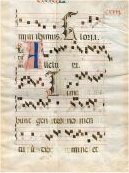|
The Greeks used two different systems of
letters were used to write down instrumental and vocal music.
. Boethius (c.A.D. 470–A.D.
525 wrote ) five textbooks on music theory and applied the
first 15 letters of the alphabet to the notes. This was at the end
of Roman times. The Gregorian chant utilized neumes,
derived from the symbols used in the Greek language which
indicated pitch inflection. Neumes were in use by the 6th cent.. The
earliest extant manuscripts using them are from the 8th cent. The
neumes conveyed the grouping of sounds in a melody, evidently to
remidn a singer of the approximate shape of a melody learned
earlier.
Heighted neumes, are arranged above and below
a line to make the intervals of a melody more discernible.
This occured by the 10th-century. By the end of the 12th century
the staff developed by Guido d'Arezzo used. Guido put letters
on specific lines to indicate pitch. The pitch of the remaining
lines and spaces was derived from the lines.. The letters changed into
clef signs which are used today. Guido invented a system of naming scale
degrees. This used the first syllables of the lines of a Latin hymn (ut,
re, mi, fa, sol, la). First used for teaching sight singing, these
or derivatives are used in some languages for naming absolute
pitches.
A staff of five lines for vocal music was
adopted in France. A staff of six lines was used in Italy.
Instrumental music used staves of varying numbers of lines until the 16th
century. At this time the five-line staff became standard. Signs for
chromatic changing of tones appear in the earliest notation. They took on
their their modern shapes by the end of the 17th century.
It took longer to develop rhythmic
notation. Mensural notation, wherein each note has a
specific time value, was required for the development of polyphony. First,
specific patternings of neumes were used to notate the
rhythmic modes. In his work Ars cantus mensurabilis
(c.1280), Franco of Cologne devised a clear indication for each note
of exact rhythmic length and chose specific neumes to notate
tones of long and short length. In this notation, the long value was equal
to three of the short values.
In the 14th century. Philippe de Vitry,
author of Ars nova, standardized the duple divisions of the
long and short notes. Either a 2:1 or a 3:1 relationship was
implied. A system of signs and colored notes was created to indicate
which relationships were notated or were being altered.
In the 15th century fractions notated
that one proportionality of rhythmic values was to be substituted
for another. Modern signatures came from these numbers. Bar lines,
expression signs, and Italian terms to indicate tempo and dynamics became
popular in the 17th century. Around this time equal
temperament was adopted and major and minor modes, signatures
notating a major key or its relative minor became conventional. They
assumed modern form during the baroque period.
The creation aleatory music has also
lead to the creation of notation systems. These vary from piece to
piece. They notate only approximate pitch, duration, and dynamic
relations. Notation for electronic music has not been
standardized. It does use traditional symbols along with
special pitch and rhythm notation. | 
